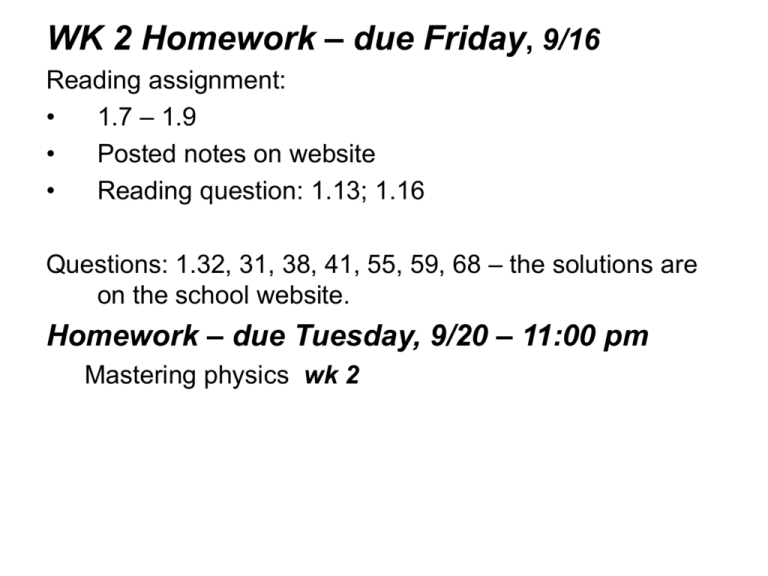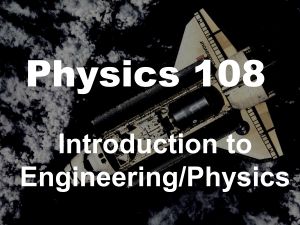by a vector
advertisement

WK 2 Homework – due Friday, 9/16 Reading assignment: • 1.7 – 1.9 • Posted notes on website • Reading question: 1.13; 1.16 Questions: 1.32, 31, 38, 41, 55, 59, 68 – the solutions are on the school website. Homework – due Tuesday, 9/20 – 11:00 pm Mastering physics wk 2 Vectors • A vector is a mathematical entity that possesses two properties, which physically we call magnitude and direction. displacement, velocity, acceleration, force, and momentum are vector quantities. • A scalar is a mathematical entity that has one property, magnitude, only. Temperature, mass, speed, and energy are scalar quantities. Scalars obey the familiar rules of addition, multiplication, etc. • The operation of vector include: – Addition, – Subtraction, – Multiplication • by a scalar, • by a vector: – Dot product, – Cross product • Two ways to represent vectors – Geometric approach • Vectors are symbolized graphically as arrows, in text by bold-face type or with a line/arrow on top. A y y1 o – Algebraic approach • To describe motion of an ideal particle, we choose a coordinate system, e.g. Cartesian x, y, z. The system must be an inertial coordinate system, which means it is non-accelerated. p(x1, y1) x1 x Representing vector geometrically • If two vectors have the same size and same direction, they are equal. = = = • If two vectors have the same size but opposite direction, then we say one vector is the negative of the other. A B A =- B Adding vectors A B C • The sum of two vectors is also a vector. • Graphical method: Vectors are represented by arrows, drawn to scale. Place the tail of the 2nd vector on the head of the 1st, preserving the relative orientations. The resultant vector extends from the tail of the 1st to the head of the 2nd vector. • The sum of two vectors is also a vector. • Addition makes sense only for same kinds of vectors The order of addition does not matter! parallelogram Head and tail method Parallelogram method Adding 3 or more vectors Subtract vectors: adding a negative vector Multiplication: scalar x vector representing vector algebraically • A vector can be completely describe by its components in a coordinate system. The origin of the systems is the tail of vector r is a position vector from the origin to the point x, y, z The position vector r of the point P. Unit vectors • A unit vector is a vector that has a magnitude of 1, with no units. Its only purpose is to point, or describe a direction in space. • Unit vector is denoted by “^” symbol. • For example: – ^ i represents a unit vector that points in the direction of the + x-axis y j unit vector points in the + y-axis – ^ ^ j – ^ k unit vector points in the + z-axis A unit vector in any direction is represented by: • where a is the magnitude of the z a vector a . Often, the magnitude of a aˆ a vector is indicated by the letter without the line on top: a a ^ k ^ i x • Any vector can be expressed with unit vectors: A = Ax ^ i + Ay ^ j + Az ^ k The components Ax, Ay, Az of an arbitrary vector A. In 2 dimensions Addition/subtraction of vectors algebraically Example: inclined plane example a. Is the vector A = ^ i + ^ j + ^ k a unit vector? b. Can a unit vector have any components with magnitude greater than unity? Can it have any negative components? ^ ^ A = a (3.0 i + 4.0 j ), where a is a c. If constant, determine the value of a that makes A a unit vector. Example - Finding components • What is the x- and y- components of vector D in a) where the magnitude of the vector is D = 3.00 m and the angle θ = 45o? What is the x- and y- components of vector E in b) where the magnitude of the vector is E = 4.50 m and the angle θ = 37o? • y Dx (+) Ex (+) x Ey (+) θ=45o Dy (-) a) θ=37o D E b) y x example • a. b. c. d. Let the angle θ be the angle that the vector A makes with the + x-axis, measured counter clockwise from that axis. Find the angle θ for a vector that has the following components: Ax = 2.00 m; Ay = -1.00 m Ax = 2.00 m; Ay = 1.00 m Ax = -2.00 m; Ay = 1.00 m Ax = -2.00 m; Ay = -1.00 m Example – adding vectors with components • Three players on a reality TV show are brought to the center of a large, flat field. Each is given a meter stick, a compass, a calculator, a shovel, and the following three displacements; – 74.4 m 32.0o east of N – 57.3 m, 36.0o south of west – 17.8 m straight south • The three displacement lead to the point where the keys to a new Porsche are buried. Two players start measuring immediately, but the winner first calculates where to go. What does she calculate? R=A+B+C Example – using unit vectors Given the two displacement A =(6 ^ i + 3^ j -^ k) m ^ ^ B =(4i - 5 j + 8 ^ k) m • Find the magnitude of the displacement 2A - B Multiplying vectors • There are two kinds of products of vectors – Scalar product or dot product, yields a result that is a scalar quantity – Vector product or cross product, yields another vector Scalar product or dot product Proof: example Application of scalar product • When a constant force F is applied to a body that undergoes a displacement d, the work done by the force is given by W = F∙d The work done by the force is • positive if the angle between F and d is between 0 and 90o (example: lifting weight) • Negative if the angle between F and d is between 90o and 180o (example: stop a moving car) • Zero and F and d are perpendicular to each other (example: waiter holding a tray of food while walk around) Finding the angles with the scalar product • Find the dot product and the angle between the two vectors AxBx + AyBy + AzBz A · B = |A||B|cosθ = |A| = √Ax2 + Ay2 + Az2 |B| = √Bx2 + By2 + Bz2 cosθ = A·B |A||B| = AxBx + AyBy + AzBz (√Ax2 + Ay2 + Az2 )(√Bx2 + By2 + Bz2 ) •if cosθ is negative, θ is between 90o and 180o example ? ? example • Find the scalar product A∙B of the two vectors in the figure. The magnitudes of the vectors are A = 4.00 and B = 5.00 B y 130o A θ 53.0o x Finding the angles with the scalar product • Find the dot product and the angle between the two vectors A = 2i + 3j + k B = -4i +2j - k Vector product or cross product • The vector product of two vectors A and B, also called the cross product, is denoted by A x B. • The vector product is a vector. It has a magnitude and direction The direction of a vector (cross) product Place the vector tail to tail, they define the plane AxB B θ A A x B is perpendicular to the plane containing the vectors A and B. It direction is determined by the righthand rule. Right-hand rule: That is, if we follow the direction of the fingers to go from the A to B, then the thumb points in the direction of A x B AxB B θ BxA=-AxB A θ A B BxA Magnitude of a vector (cross) product A x B = ABsinθ Where θ is the angle from A toward B, and θ is the smaller of the two possible angles. Since 0 ≤ θ ≤ 180o, 0 ≤ sinθ ≤ 1, A x B is never negative. Therefore, the magnitude of a vector product is never negative. Note when A and B are in the same direction or in the opposite direction, sinθ = 0; The vector product of two parallel or anti-parallel vectors is always zero Vector product vs. scalar product • Vector product: – A x B = ABsinθ (magnitude) – Direction: right-hand rule-perpendicular to the A, B plane • Scalar product: – A∙B = ABcosθ (magnitude) – It has no direction. • When A and B are parallel • When A and B are perpendicular to each other – AxB is zero – A∙B is maximum – AxB is maximum – A∙B is zero Calculating the vector product using components • If we know the components of A and B, we can calculate the components of the vector product. • The product of any vector with itself is zero *i x i = 0; j x j = 0; k x k = 0 • Using the right hand rule and A x B = ABsinθ *i x j = -j x i = k; *j x k = -k x j = i; *k x i = - i x k = j A x B = (Axi + Ayj + Azk) x (Bxi + Byj + Bzk) = AxByk - AxBzj – AyBxk + AyBzi + AzBxj - AzByi A x B = (AyBz – AzBy) i + (AzBx - AxBz) j + (AxBy – AyBx) k If C = A x B then Cx = AyBz – AzBy; Cy = AzBx - AxBz; Cz = AxBy – AyBx The vector product can also be expressed in determinant form as AxB= i j k i j k Ax Ay Az Ax Ay Az Bx By Bz Bx By Bz - direction + direction A x B =(AyBz – AzBy) i + (AzBx - AxBz) j + (AxBy – AyBx) k Example 1.12 • Vector A has magnitude 6 units and is in the direction of the + x-axis. Vector B has magnitude 4 units and lies in the xy-plane, making an angle of 30o with the + x-axis (fig. 1.32). Find the vector product C = A x B. y B 30o A C z x example • Find the vector product A X B (expressed in unit vectors) of the two vectors given in the figure. A (3.60 m) 70o 30o B (2.4 m) Class work Homework – due Friday, 9/23 Reading assignment: • 12.6; 2.1-2.6 Questions: 2, 7, 9, 12, 13, 22, 23, 24, 25, 29, 31, 34, 40, 44 – the solutions are on the school website. Homework – due Tuesday, 9/20 – 11:00 pm Mastering physics wk 3




